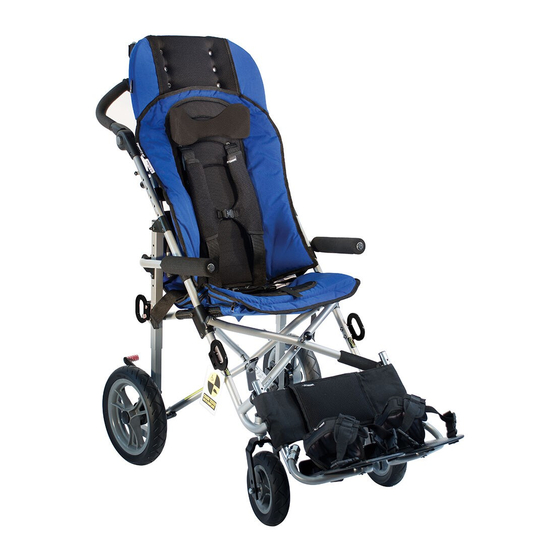
Table of Contents
Advertisement
Quick Links
ENGLISH
WC19-Compliancy Transit Policy, User's Manual, Warranty Information
Transit Guide
Metro Transit Chair
Cruiser Transit Chair
Cruiser Planar Transit Chair
Scout Transit Chair
EZ Rider Transit Chair
EZ Rider Planar Transit Chair
Convertible Transit Chair
Convertible Planar Transit Chair
Rodeo Transit Chair
Safari Transit Chair
Mountee Transit Seating System
Profiler Transit Chair
Clipper Transit Chair
READ INSTRUCTIONS BEFORE USING YOUR NEW WHEELCHAIR
SAVE THIS BROCHURE FOR FUTURE REFERENCE
Advertisement
Table of Contents

Summary of Contents for Convaid WC19
- Page 1 ENGLISH WC19-Compliancy Transit Policy, User’s Manual, Warranty Information Transit Guide Metro Transit Chair Cruiser Transit Chair Cruiser Planar Transit Chair Scout Transit Chair EZ Rider Transit Chair EZ Rider Planar Transit Chair Convertible Transit Chair Convertible Planar Transit Chair Rodeo Transit Chair...
-
Page 2: Table Of Contents
..Wheelchairs Used as Seating in Motor Vehicles ANSI/RESNA WC19 ......Wheelchair Lateral Stability and Belt... -
Page 3: Introduction
(Largest and smallest sizes of each model have been crash-tested at a leading U.S. university; intermediate sizes may be certified to standard by Convaid.) Proper use of your Convaid transit wheelchair will significantly reduce the likelihood of injury in the event of a motor-vehicle accident. -
Page 4: Warnings & Precautions
8. If the wheelchair has been involved in a vehicle crash that requires the vehicle to be towed, it may have been structurally damaged, which could compromise its safety and effectiveness. Wheelchairs involved in such incidents should be returned to Convaid for inspection and evaluation. - Page 5 WARNINGS & PRECAUTIONS RECOMMENDED CLEAR ZONES IN VEHICLE Fig. 1 SIDE VIEW Note -- Both pelvic and torso restraint belts must be used while traveling aboard a motor vehicle. Dimensions shown in millimeters. Fig. 2 The rear clear zone is measured from the rearmost point on an occupant’s head.
-
Page 6: Passenger Safety
Passenger Safety Wheelchairs Used as Seating in Motor Vehicles Before attempting to use your Convaid transit wheelchair as a seat in a motor vehicle, please take a moment to become familiar with some fundamental principles of occupant safety: Most serious or fatal injuries occur during frontal-impact crashes. - Page 7 When you use your Convaid transit wheelchair as seating in a motor vehicle, it is vital that you use a wheelchair tiedown and occupant restraint system (WTORS) that complies with SAE J2249.
- Page 8 WTORS manufacturer’s instructions. Securement points are identified by the symbol in Fig. 4. and their location on the wheelchair illustrated in Fig. 5. You must use all four tiedown straps when securing your Convaid wheelchair in a motor vehicle. hook-type end fitting...
- Page 9 PASSENGER SAFETY...
- Page 10 CONVAID TRANSIT GUIDE Wheelchair Lateral Stability and Belt Restraint Accommodation Ratings Mass Wheelchair Test Rating Lateral (Weight) of Model Stability ** (A,B,C,D)* (in. / mm) Wheelchair (lb. / kg) Cruiser Transit 10 19.0 / 8.6 0.25 / 6.4 Cruiser Transit 12 19.1 / 8.7...
-
Page 11: Wheelchair Lateral
Higher numbers indicate less stability. This table refers to tests performed in accordance with WC19 to establish lateral stability during normal travel and the ease of use and proper fit of vehicle-anchored belt restraints. The letter designation reflects the overall... -
Page 12: Crash-Tested, Wc19-Compliant Seating Options
CONVAID TRANSIT GUIDE Crash-Tested, WC19-Compliant Seating Options Fabric Seat Solid Seat Solid Seat Frame Only and/or and/or & Back with Approved Back Cushion Back Cushion Seating System (Standard) (Optional) Cruiser Scout Clipper C-2000 EZ Rider Convertible Safari Rodeo Metro Cruiser Planar... -
Page 13: Proper Use Of Equipment
Proper Use of Equipment The correct use of equipment that complies with SAE J2249 and ANSI/RESNA WC19 may not prevent all crash-related injuries to wheelchair- seated occupants, but it will greatly reduce the risk of serious injuries. Securing the Wheelchair... - Page 14 CONVAID TRANSIT GUIDE FIG. 7: FRONT TIEDOWN STRAPS PREFERRED ANGLES OF FRONT AND REAR TIEDOWN ANGLED AWAY FROM SIDES OF STRAPS (TOP) AND PREFERRED LOCATIONS OF WHEELCHAIR. FLOOR ANCHOR POINTS (BOTTOM). FIG. 8: CORRECT POSITIONS OF SHOULDER AND LAP BELT RESTRAINTS AND WHEELCHAIR TIEDOWNS.
-
Page 15: Providing Clear Space & Padding
The optional belt, which has been dynamically tested in accordance with Annex A of WC19, may be ordered from Convaid at a nominal additional cost. To attach the lap belt to the wheelchair, secure the metal clips at the ends of the lap belt (Fig. -
Page 16: Using Postural Belts & Supports
SAE J2249 and/or ANSI/RESNA WC19. - Page 17 PROPER USE OF EQUIPMENT PREFERRED AND OPTIONAL ANGLES OF PELVIC (LAP) BELT RESTRAINTS. Note: Steeper side-view pelvic-belt angles are especially important if the pelvic belt is intended to be used for postural support in addition to occupant restraint in a frontal crash. Steeper angles will reduce the tendency for a vertical gap to develop between the user and the belt due to compliance of seat cushions and belt...
-
Page 18: Trays & Other Wheelchair Components
WTORS Manufacturers Convaid is a wheelchair manufacturer and does not offer wheelchair tiedown and occupant restraint systems (WTORS). However, products that comply with current WTORS standards can be obtained from the following companies... - Page 19 Due to normal wear and tear or after an extended period of use, your Convaid transit wheelchair may no longer meet the original crash-test standards. To...
-
Page 20: For Answers To Your Questions
CONVAID TRANSIT GUIDE Contact Us Thank you for choosing Convaid transit wheelchairs. We welcome your For questions regarding using your wheelchair as comments. seating in a motor vehicle, please contact us at: Convaid, Inc. P.O. Box 4209 Palos Verdes, CA 90274...
















Need help?
Do you have a question about the WC19 and is the answer not in the manual?
Questions and answers